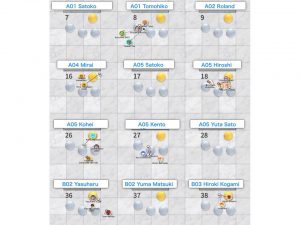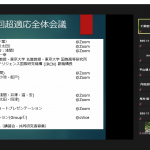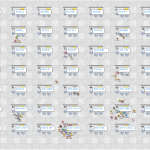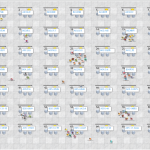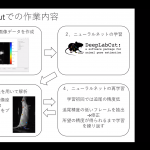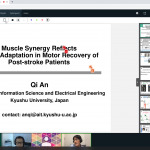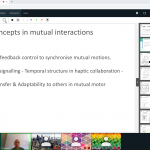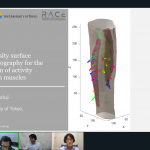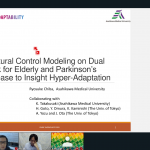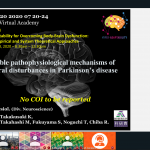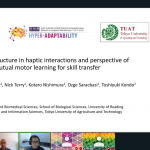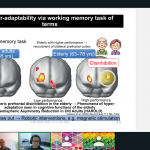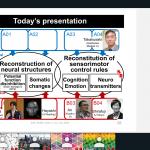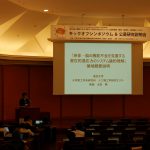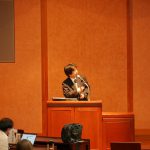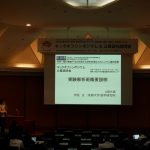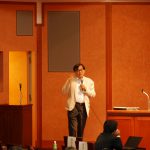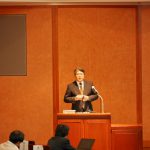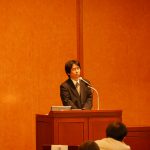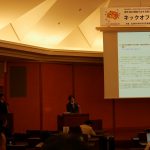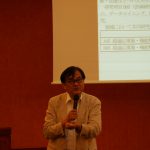International Symposium on Hyper-Adaptability HypAd 2021
The 1st International Symposium on Hyper-Adaptation was held on online from May 26 to 27, 2021. Prof Andrea d’Avella of the University of Messina gave us a lecture entitled “Virtual surgeries to investigate motor learning and to enhance motor rehabilitation.” His talk was closely related to a muscle relocation model of hyper-adaptability, on which our project is working. He gave us a lot of pointers to our future directions. Principal investigators (PIs) of the planned research groups reported their progress in talk sessions. PIs of the open-recruited groups and others presented their recent results in poster sessions. The discussions heated up just before our mid-term evaluation. The symposium succeeded with 161 participants and 58 posters despite the meeting closed to the project members.
The 2nd General meeting
The 2nd General meeting of the “Hyper-adaptability” was held online on Mar. 5-6, 2021. The purpose of the meeting was to report the results of each research project in 2020 and to promote collaborative research. General lectures used Zoom, and poster sessions used oVice, a virtual communication space, and Slack. In addition, we had a reception on oVice after the conference. We had following events for the reception, “Introduction of the common motion analysis platform”, “collaborative research proposal”, and “round-table talk”. At the meeting, Professor AIHARA Kazuyuki (The University of Tokyo) gave a keynote lecture titled “Mathematical Approach to Biological Networks” at the beginning, followed by reports of the results from each planned research and poster sessions. There were 146 participants and 68 poster presentations and had active discussions.
The 1st General Public Symposium on “Hyper-adaptation”
On Saturday, Oct. 10, 2020, we held a general public symposium on the field of “Hyper-adaptation.” The theme was “Hyper-adaptation in a post-coronavirus society.” The symposium focused on the decline in motor functions due to the restricted activities caused by the corona disaster, the resulting maladaptation in the body-brain relationship, and the prospects for solutions. After an overview by Professor Ota, Professor Isa (Kyoto University) gave a presentation on “Brain Circuits Connecting Mind and Body,” Professor Takakusagi (Asahikawa Medical University) on “Challenged Person and Post-Corona,” Professor Tsutsui (Tohoku University) on “Future, Hope, and Motivation in the Brain,” Professor Maeda (Keio University) on “Creative Evolution of Initiative to Adapt to New Realities: How Humans Connect with Each Other,” Professor Asama (The University of Tokyo) on “Robot Technology and Human Understanding Required in Post-Corona Society,” and Professor Hanakawa (Kyoto University) on “Hyper-adaptation in Dementia,” followed by a panel discussion on the theme of post-corona and hyper-adaptation. The meeting was held via a Zoom webinar, and a large number of participants attended and engaged in lively discussions.
EMBC2020 Workshop (Online)
On Saturday, July 18, 2020, we held a workshop at the International Conference EMBC2020. Professor Ota, President of our group, gave an overview of the workshop, and Professor Takakusaki, Professor Chiba, Professor Shirafuji, and Professor An gave presentations. Although the workshop was held online due to the Covid-19 catastrophe, active discussions were held with many participants.
The 1st general meeting (online meeting)
1st General meeting of the “Hyper-adaptability” was held on Mar. 4-5, 2020. Considering the effect of COVID-19, the meeting was changed to be an online meeting (Zoom). Approx. 50 people participated from more than 35 places, and shared various opinions.
Kickoff symposium
Kickoff symposium of the “Hyper-adaptability” was held on Sep. 20, 2019, 13:30-16:00 at Ito Hall, the University of Tokyo. Area representative: Professor Jun Ota (University of Tokyo) introduced the overview of our area, and then Professor Isa (Kyoto University, Group A representative) and Professor Kondo (Tokyo University of Agriculture and Technology, Group B representative) introduced the research plan of each group. After a break, Professor Ota explained about public offering. More than 100 people participated in the symposium and shared various opinions.
Information about the public offering can be obtained from the following website.
http://www.mext.go.jp/a_menu/shinkou/hojyo/boshu/1397884.htm

